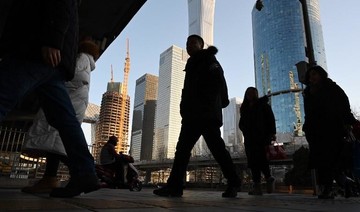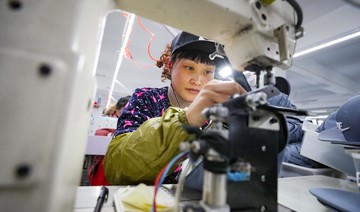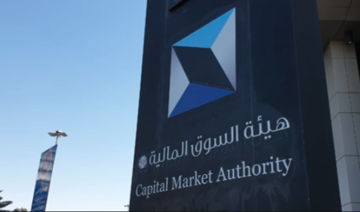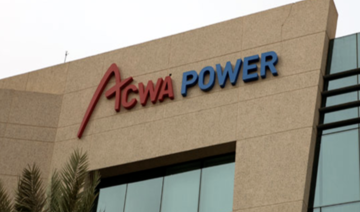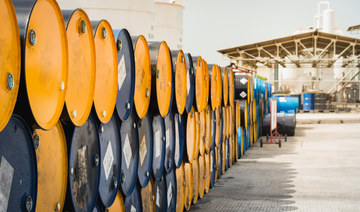BEIJING: China’s industrial output slowed during the first two months of the year as unemployment rose, official data showed Thursday, while some indicators showed a slowdown in the world’s second largest economy stabilizing.
The figures from the National Bureau of Statistics come as Beijing and Washington appear to be nearing a deal to resolve their painful trade spat, and Chinese leaders convene in the capital for an annual parliamentary session.
Output growth at China’s factories and workshops for the first two months slowed to 5.3 percent on-year, from 5.7 percent in December, a multi-year low and short of forecasts.
“We must be aware that there are many uncertainties and instabilities from the external environment,” said NBS spokesman Mao Shengyong. “The economy faces downward pressure,” he told reporters.
China’s normally steady unemployment rate rose to 5.3 percent in February, from 4.9 percent in December, with the NBS saying it had expected worse numbers.
Chinese Premier Li Keqiang last week laid out a lower growth target of 6.0-6.5 percent this year, from 6.6 percent growth in 2018, which was already the slowest pace for almost three decades.
Policymakers huddled in Beijing have talked up plans to support the economy, announcing tax cuts, fee reductions, and financing support. A plan to cut value-added tax for manufacturers will help the struggling sector.
In January and February car sales continued to fall and manufacturing activity sunk.
The latest data showed growth in retail sales for January-February remained flat from December, rising 8.2 percent on-year and slightly above forecasts from economists polled by Bloomberg News.
However, retail sales remain near a 15-year low, said Julian Evans-Pritchard of Capital Economics in a note, adding that “the near-term outlook still looks downbeat.”
Beijing is counting on consumers and renewed investment to stabilize the economy.
Fixed-asset investment rose 6.1 percent in the first two months, from 5.9 percent in 2018.
Last year investment in infrastructure crumbled as China hit the brakes on major projects such as subway lines and motorways to keep a lid on debt.
Beijing has tried to restart spending. Infrastructure spending ticked up 4.3 percent on-year in January-February, from 3.8 percent last year.
Still it remains well below the near 20 percent growth seen for many years.
“Infrastructure investment disappointed in the first two months, suggesting that government efforts to accelerate it have not yet yielded material impact,” said Louis Kuijs of Oxford Economics.
China is grappling with a decline in global demand — most notably from the US, which launched a trade war last year.
US President Donald Trump said Wednesday he sees a “very good chance” of reaching a trade deal with China but is in “no rush” to reach an agreement.
The two sides have exchanged tariffs on more than $360 billion in two-way trade, and China’s exports and imports plummeted much more than expected in February.
“We expect economic growth to remain under pressure in the coming months from slowing exports and still subdued sentiment,” said Kuijs.
The slowdown has stalled price growth in the country’s industrial sector while consumer inflation has eased.
China’s industrial output slows, unemployment rises
China’s industrial output slows, unemployment rises
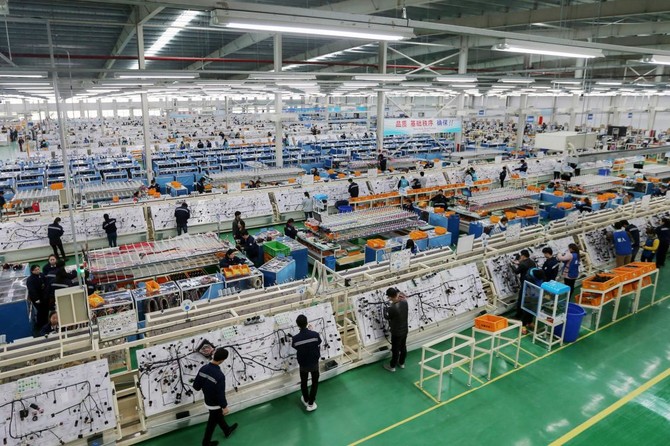
- Output growth at China’s factories and workshops for the first two months slowed to 5.3 percent on-year
- China is grappling with a decline in global demand — most notably from the US, which launched a trade war last year
Saudi financial sector expands ambitions, eyes foreign investment surge: report
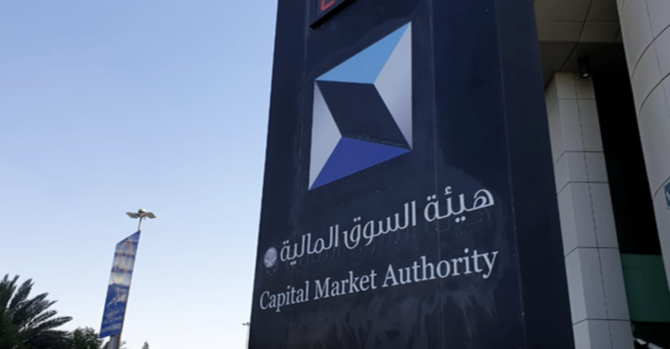
RIYADH: Saudi Arabia aims to enhance its stock exchange appeal to foreign investors, targeting 17 percent ownership of free float shares by 2024, a new report has revealed.
According to the 2023 Financial Sector Development Program document, the Saudi Capital Market Authority plans to boost assets under management to 29.4 percent of gross domestic product by 2024 by increasing the investment environment and attracting more investors.
The report, published annually, highlights the achievements in the financial sector, particularly the Kingdom’s ongoing progress in competitiveness indicators related to the capital market, as stated by Mohammed Al-Jadaan, minister of finance and chairman of the FSDP.
Commenting on the development of the financial sector, Al-Jadaan emphasized the importance of innovation and investment in talent and technology.
“We have placed innovation and investment in both talent and technology at the top of our priorities, because we recognize the importance of building a dynamic financial environment that allows companies — especially startups — to flourish and succeed,” the minister stated.
In line with its commitment to facilitating financing in the capital market, the CMA also plans to accelerate the pace of listings by welcoming 24 new companies in 2024.
Moreover, there will be a focus on supporting the development of new and promising sectors, with a target of having micro and small enterprises account for 45 percent of total listings.
Another area of emphasis is the deepening of the sukuk and debt instruments market, with the goal of increasing the debt-to-GDP ratio to 22.1 percent by the end of 2024. These measures aim to provide diverse financing options for companies and further stimulate economic growth.
“The capital market ecosystem continued its efforts to contribute to developing the financial sector and achieving the Saudi Vision 2030,” stated Mohammed El-Kuwaiz, chairman of the CMA.
“By approving rules for foreign investment in securities and streamlining regulatory procedures, we have witnessed a significant increase in foreign investments in the capital market, reaching SR401 billion ($106.9 billion),” El-Kuwaiz added.
The Saudi Central Bank also reaffirmed its commitment to adhering to international standards and best practices to enhance the strength and stability of the financial sector.
Initiatives such as developing digital solutions for supervising the financial sector and enabling local and international FinTechs demonstrate the Kingdom’s dedication to embracing technological advancements.
Furthermore, the Financial Academy unveiled its new strategy for 2024-2026, focusing on enhancing human capabilities in the financial sector through training programs and professional certifications.
The academy aims to increase the number of trainees and improve the quality of its services to meet the evolving needs of the industry.
The 2023 FSDP report highlighted significant progress across sectors like fintech and digital banking.
The Kingdom saw a surge in fintech companies, surpassing 2023 targets with 216 in operation and launching two digital banks.
Saudi Arabia claimed the top spot in the Corporate Boards Index among G20 nations and secured second place in various indices. Foreign companies relocated headquarters to the Kingdom, deepening the capital market.
Moody’s, Fitch, and S&P Global Ratings revised Saudi Arabia’s outlook to “Positive” and affirmed its “A1” and “A+” credit ratings, citing fiscal policy development, economic reforms, and structural improvements.
Saudi Arabia led venture investments in the Middle East & North Africa, securing 52 percent of total investments in 2023, and allocated SR10 billion to support small and medium enterprises across economic activities and regions in the first half of the year.
ACWA Power signs $1.51bn senior debt financing agreement for Qassim 1 Power Plant
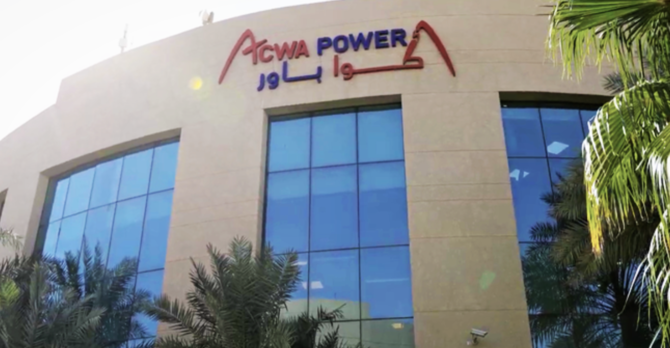
RIYADH: Saudi utility firm ACWA Power has signed a senior debt financing agreement for the Qassim 1 Combined Cycle Power Plant for SR5.69 billion ($1.51 billion).
The deal, signed through Qudra One for Electricity Co., will extend for 28 years, according to ACWA Power’s statement to Tadawul.
International and local commercial lenders, including Standard Chartered Bank, Bank of China, and Riyad Bank, as well as Saudi National Bank, Alinma Bank, Saudi Investment Bank, and Saudi Awwal Bank, financed the senior debt.
Abu Dhabi’s ADQ lists debut $2.5bn bonds on London Stock Exchange

The smallest of three Abu Dhabi sovereign wealth funds ADQ has listed a dual tranche $2.5 billion bond on the London Stock Exchange, the fund said in a statement.
The fund sold a $1.25 billion five-year portion at 80 basis points over US Treasuries and another $1.25 billion 10-year tranche at 90 bps over the same benchmark, fixed income news service IFR reported.
Citigroup, Credit Agricole, First Abu Dhabi Bank, Goldman Sachs International, HSBC and Standard Chartered were joint global coordinators and active bookrunners on the bond issuance deal.
The proceeds from the debt sale, which was oversubscribed more than 4.4 times, will diversify ADQ’s funding mix, enhance financial resilience and contribute growth capital.
US Fed leaves rates unchanged, flags ‘lack of further progress’ on inflation
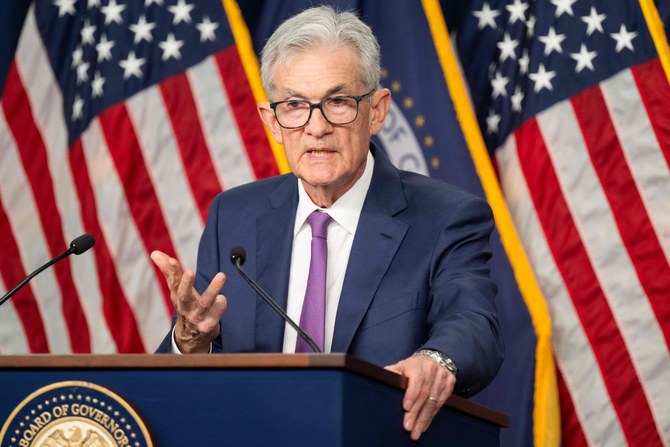
- Policy rate remains in 5.25 percent-5.50 percent range
- Fed policymakers concerned by recent inflation data
- Markets take ‘dovish’ view of Fed chief’s remarks
WASHINGTON : The US Federal Reserve held interest rates steady on Wednesday and signaled it is still leaning toward eventual reductions in borrowing costs, but put a red flag on recent disappointing inflation readings that could make those rate cuts a while in coming, Reuters reported.
Indeed, Fed Chair Jerome Powell said that after starting 2024 with three months of faster-than-expected price increases, it “will take longer than previously expected” for policymakers to become comfortable that inflation will resume the decline toward 2 percent that had cheered them through much of last year.
That steady progress has stalled for now, and while Powell said rate increases remained unlikely, he set the stage for a potentially extended hold of the benchmark policy rate in the 5.25 percent-5.5 percent range that has been in place since July.
US central bankers still believe the current policy rate is putting enough pressure on economic activity to bring inflation under control, Powell said, and they would be content to wait as long as needed for that to become apparent — even if inflation is simply “moving sideways” in the meantime.
The Fed’s preferred inflation measure — the personal consumption expenditures price index — increased at a 2.7 percent annual rate in March, an acceleration from the prior month.
“Inflation is still too high,” Powell said in a press conference after the end of the Federal Open Market Committee’s two-day policy meeting. “Further progress in bringing it down is not assured and the path forward is uncertain.”
Powell said his forecast remained for inflation to fall over the course of the year, but that “my confidence in that is lower than it was.”
Whether there are rate cuts this year or not remains in doubt.
“If we did have a path where inflation proves more persistent than expected, and where the labor market remains strong but inflation is moving sideways and we’re not gaining greater confidence, well, that would be a case in which it could be appropriate to hold off on rate cuts,” Powell said. “There are paths to not cutting and there are paths to cutting. It’s really going to depend on the data.”
Despite the uncertainty of the current economic moment, Powell’s characterization of rate hikes as “unlikely” cheered investors concerned about a newly hawkish Fed chief.
US stock and bond prices turned higher as Powell preached patience that may delay rate cuts, but also means a high bar for any more hikes. The Fed raised its benchmark policy rate by 5.25 percentage points in 2022 and 2023 to curb a surge in inflation.
Powell’s remarks on Wednesday were “notably less hawkish than many feared,” said analysts at Evercore ISI. “The basic message was that cuts have been delayed, not derailed.”
Investors in contracts tied to the Fed’s policy rate increased bets that rate cuts could begin in September rather than later in the year as reflected in earlier market pricing.
Balance Sheet
The Fed’s latest policy statement kept key elements of its economic assessment and policy guidance intact, noting that “inflation has eased” over the past year, and framing its discussion of interest rates around the conditions under which borrowing costs can be lowered.
“The Committee does not expect it will be appropriate to reduce the target range until it has gained greater confidence that inflation is moving sustainably toward 2 percent,” the Fed repeated in its unanimously-approved statement.
That continues to leave the timing of any rate cut in doubt, and Fed officials made emphatic their concern that the first months of 2024 have done little to help the cause.
“In recent months, there has been a lack of further progress toward the Committee’s 2 percent inflation objective,” the Fed said in its statement.
The US central bank also announced it will scale back the pace at which it is shrinking its balance sheet starting on June 1, allowing only $25 billion in Treasury bonds to run off each month versus the current $60 billion. Mortgage-backed securities will continue to run off by up to $35 billion monthly.
The step is meant to ensure the financial system does not run short of reserves, as happened in 2019 during the Fed’s last round of “quantitative tightening.”
While the move could loosen financial conditions at the margin at a time when the US central bank is trying to keep pressure on the economy, policymakers insist their balance sheet and interest rate tools serve different ends.
The Fed maintained its overall assessment of economic growth, saying that the economy “continued to expand at a solid pace. Job gains have remained strong and the unemployment rate has remained low.”
Powell reconciled that with the relatively weak, 1.6 percent growth of gross domestic product in the first quarter by saying that the 3.1 percent increase in private domestic demand was a better gauge of where the economy stands, with output buttressed by a recent jump in immigration.
Asked about the risk the US was entering a period of “stagflation” with stagnant growth and rising prices, Powell said current conditions are nothing like those seen in the late 1970s when prices were rising more than 10 percent annually at one point alongside high unemployment.
“Right now we have ... pretty solid growth ... We have inflation running under 3 percent,” Powell said, adding: “I don’t see the ‘stag’ and I don’t see the ‘flation,.’”
Oil Updates - prices rebound on hopes US will replenish strategic reserve
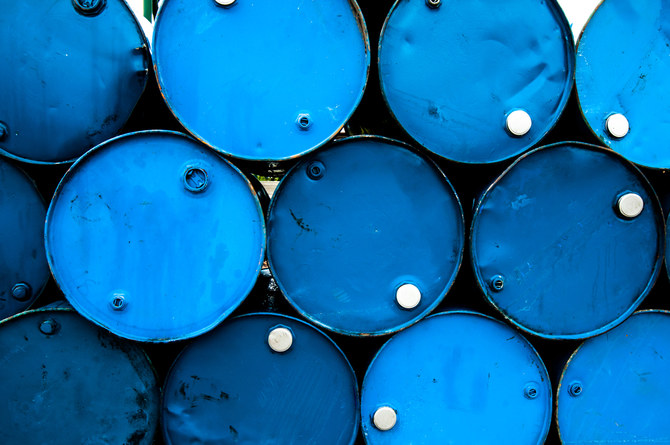
NEW DELHI: Oil prices rose on Thursday, rebounding from three days of losses, on expectations the lower levels may prompt the US, the world’s biggest crude consumer, to start replenishing its strategic reserve, putting a floor under prices, according to Reuters.
Still, prices fell more than 3 percent on Wednesday to a seven-week after the US Federal Reserve kept interest rates steady, which may curtail economic growth this year and limit oil demand increases.
Crude was also pressured by an unexpected increase in US crude inventories and signs of an impending Israel-Hamas ceasefire that would ease Middle East supply concerns.
Brent crude futures for July gained 58 cents, or 0.7 percent, to $84.02 a barrel by 9:33 a.m. Saudi time on Thursday. US West Texas Intermediate crude for June climbed 53 cents, or 0.7 percent, to $79.53 a barrel.
“The oil market was supported by speculation that if WTI falls below $79, the US will move to build up its strategic reserves,” said Hiroyuki Kikukawa, president of NS Trading, a unit of Nissan Securities.
The US has said it aims to replenish the Strategic Petroleum Reserve after a historic sale from the emergency stockpile in 2022 and wants to buy back oil at $79 a barrel or less.
In the Middle East, expectations grew that a ceasefire agreement between Israel and Hamas could be in sight following a renewed push led by Egypt.
Still, Israeli Prime Minister Benjamin Netanyahu has vowed to go ahead with a long-promised assault on the southern Gaza city of Rafah despite the US position and a UN warning that it would lead to “tragedy.”
“As the impact of the US crude stock-build and the Fed signalling higher-for-longer rates is close to being fully baked in, attention will turn toward the outcome of the Gaza talks,” said Vandana Hari, founder of oil market analysis provider Vanda Insights.
“As long as the latest bout of optimism over a ceasefire sustains, I expect a continued downside bias in crude,” Hari added.
The US Energy Information Administration said crude inventories rose by 7.3 million barrels to 460.9 million barrels in the week ended April 26, compared with analysts’ expectations in a Reuters poll for a 1.1 million-barrel draw.
Crude stocks were at the highest point since June, the EIA said.
The US Federal Reserve held interest rates steady on Wednesday and signalled it is still leaning toward eventual reductions in borrowing costs, but put a red flag on recent disappointing inflation readings.
Any delay in rate cuts could slow economic growth and dampen demand for oil.
Still, continuing supply reductions by the Organization of the Petroleum Exporting Countries and its allies, known as OPEC+, will support prices.
Analysts at Citi Research expects OPEC+ to hold output cuts through the second half of the year as it meets on June 1.
However, “if prices move to a bull case $90-100+ range, OPEC+ would likely ease cuts, providing a soft ceiling for oil,” they said in a note.


